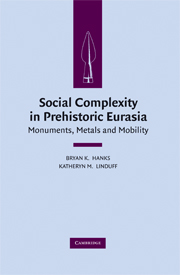Book contents
- Frontmatter
- Contents
- Contributors
- Foreword: From Myth to Method: Advances in the Archaeology of the Eurasian Steppe
- CHAPTER 1 Introduction: Reconsidering Steppe Social Complexity within World Prehistory
- PART ONE FRAMING COMPLEXITY
- PART TWO MINING, METALLURGY, AND TRADE
- PART THREE FRONTIERS AND BORDER DYNAMICS
- CHAPTER 13 Introduction
- CHAPTER 14 Violence on the Frontiers? Sources of Power and Socio-Political Change at the Easternmost Parts of the Eurasian Steppe during the Late Second and Early First Millennia BCE
- CHAPTER 15 First-Millennium BCE Beifang Artifacts as Historical Documents
- CHAPTER 16 Blurring the Boundaries: Foragers and Pastoralists in the Volga-Urals Region
- PART FOUR SOCIAL POWER, MONUMENTALITY, AND MOBILITY
- Index
CHAPTER 16 - Blurring the Boundaries: Foragers and Pastoralists in the Volga-Urals Region
from PART THREE - FRONTIERS AND BORDER DYNAMICS
Published online by Cambridge University Press: 26 January 2010
- Frontmatter
- Contents
- Contributors
- Foreword: From Myth to Method: Advances in the Archaeology of the Eurasian Steppe
- CHAPTER 1 Introduction: Reconsidering Steppe Social Complexity within World Prehistory
- PART ONE FRAMING COMPLEXITY
- PART TWO MINING, METALLURGY, AND TRADE
- PART THREE FRONTIERS AND BORDER DYNAMICS
- CHAPTER 13 Introduction
- CHAPTER 14 Violence on the Frontiers? Sources of Power and Socio-Political Change at the Easternmost Parts of the Eurasian Steppe during the Late Second and Early First Millennia BCE
- CHAPTER 15 First-Millennium BCE Beifang Artifacts as Historical Documents
- CHAPTER 16 Blurring the Boundaries: Foragers and Pastoralists in the Volga-Urals Region
- PART FOUR SOCIAL POWER, MONUMENTALITY, AND MOBILITY
- Index
Summary
Traditional models of pastoral complexity in Eurasia have been primarily concerned with the interaction between nomadic populations and settled states, particularly in the Near East (Bates and Lee 1977; Rowton 1973), Central Asia (Vinogradova and Kuz'mina 1996; Hiebert 2002), and East Asia (Barfield 1993, 2001; Di Cosmo 1994). Researchers looked to the borders of Eurasia, because they assumed that the center was relatively homogeneous (politically, culturally, and economically) in the Bronze Age. Political activities were visible, supposedly, only when groups with diametrically opposed political institutions clashed. This border-focused research strategy, however, is based upon several linked assumptions. First, the type of political organization is associated with subsistence strategy, especially in the case of pastoralists. Second, it is assumed that certain types of subsistence strategies lead to more- advanced forms of politics (i.e., farmers have states, but pastoralists do not). Third, it is argued that politics cannot be understood without history, meaning that researchers who are serious about understanding Bronze Age political complexity need the textual sources from the early states on the fringe of Eurasia.
Politics, however, is just one aspect of social organization, which is determined by the economic, cultural, and ecological underpinnings of each society. What we study, as archaeologists, is the unique way power plays out on the ground.
- Type
- Chapter
- Information
- Social Complexity in Prehistoric EurasiaMonuments, Metals and Mobility, pp. 296 - 320Publisher: Cambridge University PressPrint publication year: 2009
- 5
- Cited by

